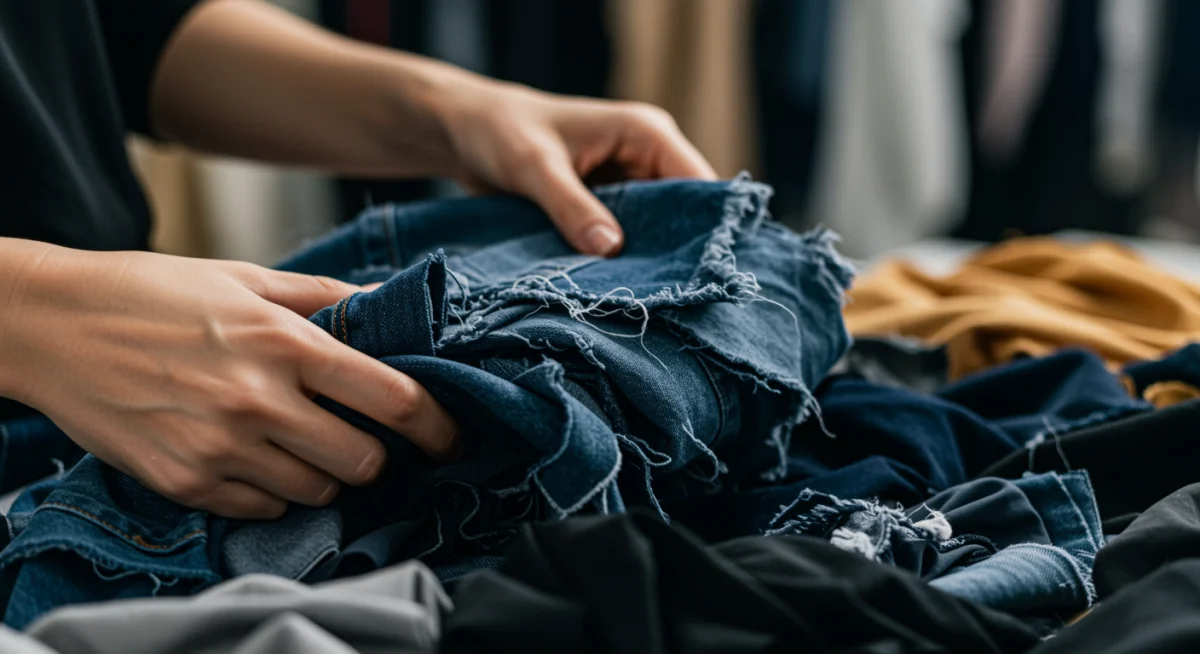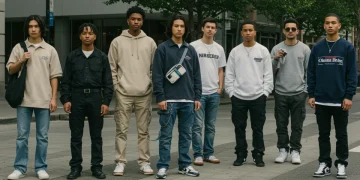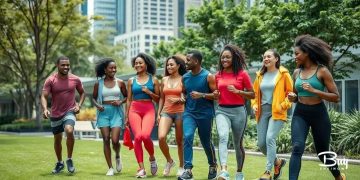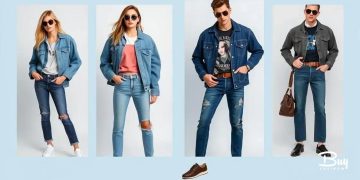Sustainable Fashion Trends 2025: US Market Insider’s Guide

The US market in 2025 will be significantly influenced by five leading sustainable fashion trends, including circularity, innovative materials, transparency, localized production, and upcycling, reshaping ethical style for conscious consumers.
As we approach 2025, the fashion landscape is undergoing a profound transformation, driven by an increasing demand for ethical and environmentally responsible practices. Consumers are no longer just looking for style; they are seeking substance, demanding transparency and sustainability from their favorite brands. This shift has given rise to the emergence of several pivotal movements, with the top 5 sustainable fashion trends dominating 2025 in the US market: an insider’s guide to ethical style becoming essential knowledge for both industry professionals and conscious shoppers alike. This article delves into these transformative trends, offering a comprehensive look at what defines the future of fashion in America.
The Rise of Circularity and Regenerative Fashion
The concept of circularity in fashion is moving beyond a niche idea to a mainstream imperative. It’s about designing out waste and pollution, keeping products and materials in use, and regenerating natural systems. In 2025, US brands are increasingly adopting circular models, emphasizing longevity, repair, reuse, and recycling throughout their product lifecycles.
This holistic approach aims to minimize environmental impact and create a closed-loop system where resources are continuously utilized. Regenerative fashion takes this a step further, focusing on practices that not only reduce harm but actively restore and replenish ecological systems, particularly in raw material sourcing.
Redefining Product Lifecycles
Brands are investing in innovative design strategies that consider a garment’s end-of-life from its inception. This includes using mono-materials to simplify recycling and designing for disassembly. The goal is to ensure that products can be easily repaired, repurposed, or returned to the biological cycle or technical cycle without losing value.
- Durability and Longevity: Emphasis on high-quality construction and timeless designs that withstand trends and wear.
- Repair and Maintenance Services: Brands offering in-house repair services or partnerships to extend garment life.
- Take-Back Programs: Initiatives allowing consumers to return used garments for recycling or resale.
- Material Innovation for Recycling: Development of fabrics that can be recycled multiple times without degradation.
The Impact of Regenerative Agriculture
Regenerative agriculture is becoming a cornerstone of sustainable sourcing, particularly for natural fibers like cotton, wool, and hemp. This practice focuses on improving soil health, increasing biodiversity, and sequestering carbon, transforming agricultural land into a carbon sink rather than a source. US consumers are actively seeking products with certifications that guarantee regenerative sourcing, pushing brands to adopt these practices.
The shift towards regenerative practices is not just about environmental benefits; it also fosters stronger, more resilient supply chains and supports local farming communities. It represents a fundamental change in how fashion interacts with the planet, moving towards a truly restorative model.
The embrace of circularity and regenerative practices signifies a mature phase in the sustainable fashion movement. It’s no longer enough to simply reduce negative impacts; the industry is now striving to create positive ones, ensuring a future where fashion contributes to environmental and social well-being.
Innovative Materials and Bio-Textiles
The quest for truly sustainable materials continues to drive innovation within the fashion industry. In 2025, the US market will see a significant surge in the adoption of bio-textiles and other cutting-edge materials that offer alternatives to conventional, resource-intensive fabrics. These innovations are crucial for reducing the environmental footprint of clothing production, from water usage to chemical pollution.
Consumers are becoming increasingly educated about material science, demanding fabrics that are not only eco-friendly but also perform well and feel luxurious. This demand is accelerating research and development into next-generation textiles that are both sustainable and desirable.
Mycelium, Algae, and Lab-Grown Fabrics
Fungi-based materials, such as mycelium leather, are gaining traction as a viable alternative to animal leather, offering similar aesthetics and durability with a significantly lower environmental impact. Algae-based textiles are also emerging, providing biodegradable options with vibrant, natural dyes. These bio-textiles represent a paradigm shift in material sourcing, moving away from petrochemicals and intensive agriculture.
- Mycelium Leather: Offers a sustainable, cruelty-free alternative to traditional leather, suitable for accessories and outerwear.
- Algae-Based Fibers: Biodegradable and can be grown with minimal resources, ideal for activewear and casual apparel.
- Lab-Grown Silk and Cotton: Developed through biotechnology, these materials reduce the land and water footprint associated with traditional farming.
- Recycled Synthetics with Enhanced Properties: Innovations in recycling processes are yielding higher-quality recycled polyester and nylon that can compete with virgin materials.
Smart Textiles and Performance Eco-Wear
Beyond natural alternatives, advancements in smart textiles are merging technology with sustainability. These include fabrics that can adapt to temperature changes, self-clean, or monitor health, all while being produced with minimal environmental harm. Performance eco-wear, designed for active lifestyles, is also seeing significant innovation, with brands prioritizing recycled content and non-toxic finishes.
The integration of technology into sustainable materials is creating a new category of intelligent fashion that not only looks good but also serves a functional purpose, aligning with the modern consumer’s desire for efficiency and environmental consciousness. These materials are not just about being ‘less bad’; they are about offering superior characteristics while being inherently sustainable. The future of fashion materials is bright, promising a blend of innovation, performance, and ecological responsibility.
Transparency and Traceability in Supply Chains
As consumers become more aware of the social and environmental impacts of their purchases, the demand for transparency and traceability within fashion supply chains has skyrocketed. In 2025, US brands are recognizing that simply claiming sustainability is no longer enough; they must provide verifiable proof of ethical practices from farm to finished garment. This trend is driven by a desire for authenticity and accountability.
Transparency builds trust, allowing consumers to make informed decisions about who they support with their purchasing power. It also forces brands to scrutinize their own operations and those of their suppliers, identifying and mitigating risks related to labor practices and environmental degradation.
Blockchain and Digital Ledger Technologies
Blockchain technology is emerging as a powerful tool for enhancing supply chain transparency. By creating an immutable record of every step in the production process, from raw material sourcing to manufacturing and distribution, blockchain ensures that information is accurate and accessible. This allows consumers to trace the journey of their clothes and verify sustainability claims.
- Verified Sourcing: Tracking the origin of raw materials, ensuring ethical and sustainable practices.
- Labor Standards Compliance: Documenting fair wages and safe working conditions at each production stage.
- Environmental Impact Data: Recording energy consumption, water usage, and waste generation in factories.
- Consumer Access: Providing QR codes or digital platforms for customers to explore product histories.
Certifications and Eco-Labeling
Beyond technological solutions, robust certification programs and clear eco-labeling play a vital role in communicating sustainability efforts. In 2025, consumers will increasingly rely on certifications like GOTS (Global Organic Textile Standard), Fair Trade, and B Corp to identify truly responsible brands. These labels provide third-party verification, simplifying the decision-making process for ethical shoppers.
Brands that invest in obtaining and prominently displaying these certifications gain a competitive edge in a crowded market. It signals a commitment to external scrutiny and adherence to recognized standards, fostering greater consumer confidence. The push for transparency and traceability is transforming the fashion industry into a more accountable and trustworthy sector, where claims are backed by verifiable data.
Localized Production and Reshoring Initiatives
The global pandemic exposed vulnerabilities in extended supply chains, prompting a renewed focus on localized production and reshoring initiatives within the US fashion market. In 2025, this trend is driven by a desire for greater control over manufacturing processes, reduced carbon footprints from transportation, and the ability to respond more quickly to consumer demands. It also supports local economies and creates domestic jobs.
Localized production allows for closer oversight of labor practices and environmental standards, contributing to overall ethical integrity. It also fosters a stronger connection between brands and their communities, promoting a sense of shared responsibility and local pride.
Benefits of Domestic Manufacturing
Bringing manufacturing closer to home offers numerous advantages beyond simply shortening lead times. It enables brands to implement more stringent quality control, experiment with smaller production runs, and engage directly with their workforce. This shift can lead to higher-quality products and more innovative design processes.
- Reduced Carbon Emissions: Significantly lowers the environmental impact associated with long-distance shipping.
- Ethical Labor Practices: Easier to monitor and ensure fair wages and safe working conditions.
- Agility and Responsiveness: Quicker adaptation to market changes and consumer feedback.
- Job Creation: Boosts local economies by creating skilled manufacturing jobs within the US.
Micro-Factories and On-Demand Production
Technological advancements, particularly in automation and 3D printing, are making micro-factories and on-demand production more feasible and cost-effective. These smaller, highly efficient manufacturing units can be located closer to urban centers, further reducing transportation and allowing for highly customized production. This minimizes waste by producing only what is needed, when it is needed.

On-demand models align perfectly with sustainable principles by eliminating overproduction, a major source of waste in the traditional fashion industry. As consumers increasingly value unique and personalized items, localized micro-factories are poised to cater to this demand while maintaining high ethical and environmental standards. The emphasis on localized production is reshaping the supply chain, making it more resilient, sustainable, and responsive to modern consumer values.
Upcycling, Rental, and Resale Platforms
The concept of extending the life of garments through upcycling, rental, and resale platforms is fundamentally altering consumer behavior and business models in the US fashion market. In 2025, these practices are no longer considered niche but are crucial components of a sustainable wardrobe. They address the issue of textile waste head-on, offering alternatives to constant new purchases and fostering a more mindful approach to consumption.
These trends empower consumers to engage with fashion in a more responsible way, whether by giving old clothes new life, temporarily accessing high-value items, or finding pre-loved treasures. The economic and environmental benefits are substantial, reducing demand for new production and diverting textiles from landfills.
The Booming Resale Market
The resale market, encompassing both peer-to-peer platforms and curated consignment shops, is experiencing explosive growth. Consumers are increasingly comfortable buying and selling pre-owned clothing, driven by both sustainability concerns and the desire for unique, affordable pieces. Luxury resale, in particular, is thriving, offering access to high-end fashion at a fraction of the original price while extending the lifecycle of expensive garments.
- Online Resale Platforms: Popular sites like The RealReal, Poshmark, and ThredUp facilitate easy buying and selling of used clothing.
- Brand-Owned Resale: More brands are launching their own resale programs to recapture value and control their brand’s secondary market.
- Vintage and Archival Fashion: A growing appreciation for unique, historical pieces that offer distinct style and reduced environmental impact.
- Circular Economy Contribution: Directly reduces the need for new production and minimizes textile waste.
Upcycling and Creative Repurposing
Upcycling, the process of transforming discarded items into new products of higher value, is gaining significant momentum in 2025. Designers and consumers alike are embracing creative repurposing, turning old garments into unique, fashionable pieces. This not only diverts waste but also fosters creativity and individuality, moving away from mass-produced uniformity.
Rental services are also expanding beyond formal wear, offering everyday apparel and accessories for a subscription fee. This allows consumers to enjoy a diverse wardrobe without the commitment of ownership, reducing overall consumption and promoting a more transient, yet stylish, approach to fashion. These innovative models collectively redefine value, prioritizing utility and sustainability over mere possession, paving the way for a truly circular fashion future.
Ethical Labor Practices and Social Equity
Beyond environmental concerns, the US sustainable fashion market in 2025 places a strong emphasis on ethical labor practices and social equity throughout the supply chain. Consumers are increasingly aware of the human cost of fast fashion and are demanding that brands ensure fair wages, safe working conditions, and respect for human rights for all workers involved in garment production. This focus on people is as critical as the focus on the planet.
Brands that prioritize social equity are building stronger, more resilient workforces and earning the loyalty of ethical consumers. This includes not only factory workers but also farmers, artisans, and everyone contributing to the fashion ecosystem.
Fair Wages and Safe Working Conditions
The movement for living wages and safe working environments continues to be a cornerstone of ethical fashion. Brands are being held accountable for ensuring that their suppliers adhere to international labor standards, providing workers with dignity and security. This often involves detailed audits, long-term partnerships with factories, and direct engagement with worker representatives.
- Living Wage Initiatives: Campaigns and brand commitments to ensure all workers earn enough to cover basic needs.
- Worker Empowerment: Supporting unions and worker representation in factories.
- Health and Safety Protocols: Implementing and monitoring strict safety standards to prevent accidents and occupational hazards.
- Transparency in Labor Practices: Publicly disclosing factory lists and audit reports.
Diversity, Equity, and Inclusion (DEI)
The sustainable fashion movement also recognizes the importance of diversity, equity, and inclusion (DEI) at all levels, from corporate leadership to marketing campaigns and product development. In 2025, brands are actively working to create a more inclusive industry that celebrates different body types, cultures, and identities, moving away from narrow beauty standards and promoting broad representation.
This includes supporting minority-owned businesses, designing for a wider range of sizes, and featuring diverse models in advertising. The commitment to social equity extends to ensuring that the benefits of sustainable fashion are accessible to all, not just a privileged few. By championing ethical labor and social equity, the fashion industry is not only becoming more sustainable but also more just and inclusive, reflecting the values of a conscious society.
Consumer Education and Mindful Consumption
A crucial trend shaping the sustainable fashion landscape in 2025 in the US is the increasing emphasis on consumer education and the promotion of mindful consumption habits. It’s no longer solely the responsibility of brands to be sustainable; consumers are actively seeking knowledge and tools to make more informed choices, moving away from impulsive, disposable fashion towards a more intentional approach to building their wardrobes.
This trend signifies a maturation of the sustainable fashion movement, where individual actions are recognized as powerful drivers of systemic change. Brands are responding by providing more educational content and fostering communities around conscious living.
Empowering Informed Choices
Consumers are hungry for information about where their clothes come from, how they are made, and their true environmental and social cost. Brands that provide clear, accessible data on their sustainability practices through their websites, social media, and product labeling are building stronger relationships with their audience. This includes details on material sourcing, manufacturing processes, and certifications.
- Educational Content: Blogs, videos, and workshops explaining sustainable practices and their impact.
- Product Storytelling: Sharing the narratives behind garments, including the people and processes involved.
- Impact Calculators: Tools that allow consumers to see the environmental savings of choosing sustainable options.
- Care and Repair Guides: Providing instructions to help consumers extend the life of their clothing.
Promoting a ‘Less But Better’ Philosophy
The concept of ‘less but better’ is gaining traction, encouraging consumers to invest in fewer, higher-quality, and more versatile pieces that will last longer. This contrasts sharply with the fast fashion model of frequent, cheap purchases. Mindful consumption also involves considering the true cost per wear, the versatility of an item, and its end-of-life options before making a purchase.
From capsule wardrobes to thoughtful purchasing decisions, consumers are actively participating in reducing textile waste and supporting brands that align with their values. This collective shift towards mindful consumption is a powerful force, pushing the entire fashion industry towards greater sustainability and responsibility, proving that consumer choices can indeed drive significant positive change.
| Key Trend | Brief Description |
|---|---|
| Circularity & Regenerative | Designing out waste, keeping materials in use, and regenerating natural systems for a closed-loop fashion economy. |
| Innovative Materials | Adoption of bio-textiles like mycelium and algae, reducing environmental impact of fabric production. |
| Transparency & Traceability | Brands providing verifiable proof of ethical practices using blockchain and robust certifications. |
| Localized Production | Increased domestic manufacturing to reduce carbon footprint and ensure ethical oversight. |
Frequently Asked Questions About Sustainable Fashion in 2025
Growing consumer awareness of environmental and social impacts, coupled with a desire for ethical consumption, is the primary driver. Brands are responding to this demand by integrating eco-friendly materials, transparent supply chains, and ethical labor practices into their operations. Public discourse and media coverage also play a significant role in educating consumers and influencing purchasing decisions.
Look for brands that provide clear transparency about their supply chain, use certified sustainable materials (e.g., GOTS organic cotton, recycled polyester), and have third-party certifications like Fair Trade or B Corp. Avoid greenwashing by researching specific claims and seeking out comprehensive sustainability reports. Authentic brands are usually open about their challenges and progress.
Technology is pivotal, enabling innovations like blockchain for supply chain transparency, advanced recycling processes for textiles, and the development of bio-textiles from sources like fungi and algae. Automation in localized micro-factories also reduces waste and enhances efficiency. These technological advancements are essential for achieving scalable and impactful sustainable solutions.
While some sustainable items may have a higher upfront cost due to ethical production and quality materials, they often offer better durability and longevity, reducing cost per wear. The rise of resale, rental, and upcycling platforms also provides affordable and accessible ways to engage with sustainable fashion without always buying new. Mindful consumption encourages investing in fewer, high-quality pieces.
Consumers can contribute by choosing durable, ethically produced garments, buying less, opting for secondhand or rented clothing, repairing items instead of discarding them, and properly recycling textiles. Supporting brands committed to transparency and ethical practices is also crucial. Educating oneself and others about sustainable choices further amplifies positive impact within the fashion ecosystem.
Embracing a Sustainable Future in Fashion
The trajectory of fashion in the US market towards 2025 is unequivocally sustainable. The top five trends – circularity, innovative materials, transparency, localized production, and ethical labor – are not isolated movements but interconnected pillars supporting a more responsible and resilient industry. These shifts reflect a profound change in both consumer values and corporate priorities, moving beyond mere aesthetics to embrace a holistic vision of ethical style. As brands continue to innovate and consumers become increasingly informed, the future of fashion promises not only beauty and creativity but also a deep commitment to environmental stewardship and social equity. Embracing these trends is not just about staying current; it’s about actively participating in shaping a better world through our sartorial choices.





